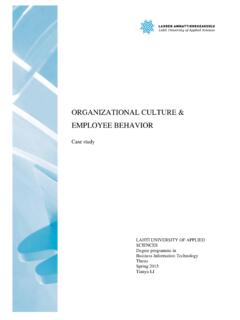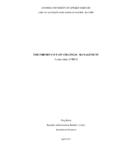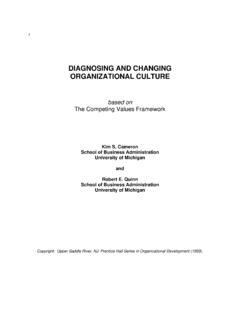Transcription of EMPLOYEE MOTIVATION AND PERFORMANCE - Theseus
1 Akah Ndang William EMPLOYEE MOTIVATION AND PERFORMANCE Ultimate Companion Limited Douala-Cameroon Bachelor s Thesis Business Management December 2010 DESCRIPTION Date of the bachelor's thesis 7 December 2010 Author(s) Akah Ndang William Degree programme and option Business Management Name of the bachelor's thesis EMPLOYEE MOTIVATION and PERFORMANCE Abstract The subject matter of this research; EMPLOYEE MOTIVATION and PERFORMANCE seeks to look at how best employees can be motivated in order to achieve high PERFORMANCE within a company or organization.
2 Managers and entrepreneurs must ensure that companies or organizations have a competent personnel that is capable to handle this task. This takes us to the problem question of this research why is not a sufficient MOTIVATION for high PERFORMANCE ? This therefore estab-lishes the fact that money is for high PERFORMANCE but there is need to look at other aspects of MOTIVATION which is not necessarily money. Four theories were taken into consideration to give an explanation to the question raised in the problem formulation.
3 These theories include: Maslow s hierarchy of needs, Herzberg two factor theory, John Adair fifty-fifty theory and Vroom s expectancy theory. Furthermore, the perform-ance management process as a tool to measure EMPLOYEE PERFORMANCE and company perform-ance. This research equally looked at the various reward systems which could be used by a com-pany. In addition to the above, culture and organizational culture and it influence on EMPLOYEE behaviour within a company was also examined. An empirical study was done at Ultimate Companion Limited which represents the case study of this research work.
4 Interviews and questionnaires were conducted to sample EMPLOYEE and management view on MOTIVATION and how it can increase PERFORMANCE at the company. Finally, a comparison of findings with theories, a discussion which raises critical issues on motiva-tion/ PERFORMANCE and conclusion constitute the last part of the research. Subject headings, (keywords) MOTIVATION , PERFORMANCE , Intrinsic, Extrinsic, Incentive, Tangible and Intangible, Reward Pages Language URN 72p. + app. 5p English Remarks, notes on appendices Tutor Marja-Liisa Kakkonen Employer of the bachelor's thesis Ultimate Companion Limited Douala-Cameroon i CONTENTS 1 INTRODUCTION.
5 1 2 NATURE OF HUMAN RESOURCE MANAGEMENT .. 4 Role of human resource management .. 4 Theories on Work MOTIVATION .. 6 Maslow s Hierarchy of Needs .. 7 Herzberg s two factor 9 Fifty-Fifty Theory .. 10 Vroom s Expectancy Theory .. 10 PERFORMANCE management .. 12 PERFORMANCE Parameters .. 12 Reward System for Employees .. 16 Purpose of Reward .. 17 Financial Reward .. 18 Nonfinancial Reward .. 20 3 culture IN HUMAN RESOURCE MANAGEMENT .. 21 The Concept of culture .. 22 Understanding Cultural Dimensions .. 24 Geert Hofstede Dimensions.
6 24 Trompenaars Dimensions .. 27 Hall s Cultural Dimensions .. 28 Managing Cultural Differences .. 29 4 RESEARCH PROCESS .. 31 Target Organization (Ultimate companion limited) .. 31 Choice of Method .. 33 Research Methods and Procedure .. 34 5 FINDINGS OF THE STUDIES .. 38 Findings from Interviews .. 38 Background Information .. 38 Work MOTIVATION .. 39 Rewards .. 42 ii Findings from Survey .. 45 Background Information of the employees .. 45 EMPLOYEE s Work MOTIVATION .. 49 EMPLOYEE s Rewards .. 53 6 DISCUSSION AND CONCLUSIONS.
7 57 Comparison of the main Findings with Previous Studies .. 57 Reliability and Validity of the Study .. 60 Analyses .. 60 Development and further studies .. 64 Conclusions .. 64 7 CONCLUDING REMARKS .. 65 67 APPENDICES LIST OF FIGURES Figure 1 Abraham Maslow's .. 8 Figure 2 Frequency distribution against EMPLOYEE s gender .. 45 Figure 3 Frequency distribution against age of employees .. 46 Figure 4 Frequency distribution against work experience of employees .. 47 Figure 5 Frequency distribution against positions of employees.
8 48 Figure 6 Frequency distribution against contract terms of employees .. 48 Figure 7 Frequency distribution against EMPLOYEE 's work environment .. 50 LIST OF TALES Table 1 summary of interviews .. 44 Table 2 EMPLOYEE 's satisfaction .. 53 Table 3 survey summary on EMPLOYEE rewards and work motivations .. 56 1 1 INTRODUCTION Managers within companies or organizations are primarily responsible to ensure the tasks or job is done through employees in the right way. To achieve this, these manag-ers must ensure that they have a competent personnel department for the recruitment of the best employees that are capable to do the job.
9 For the company to optimize em-ployee s PERFORMANCE there is need for the employees to be sufficiently motivated. Therefore, MOTIVATION in theory and practice becomes a difficult subject touching on several disciplines. Although a lot of scholarly research has been written on motiva-tion, this subject is not clearly understood and more often than not poorly practiced. On this score, to best understand how MOTIVATION can impact on EMPLOYEE s perform-ance one must understand human nature. In as much as MOTIVATION impacts on em-ployee PERFORMANCE , there is need to blend the appropriate motivational tools with effective management and leadership to achieve this goal.
10 Not withstanding the fact that MOTIVATION is very important to determine EMPLOYEE s ability so do other factors such as the resources given to an EMPLOYEE to do his or her job. Therefore, successful work PERFORMANCE can arise from a variety of motives. For instance, two people doing similar jobs may both be successful for different reasons, one salesperson may be motivated by the commission earned on sales, while the other may be more concerned about meeting sales targets. This creates a nuance in the sub-ject matter because MOTIVATION to enhance PERFORMANCE varies from person to person and from company to company.











